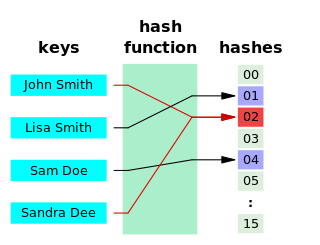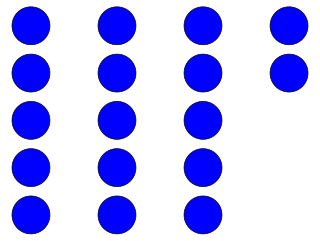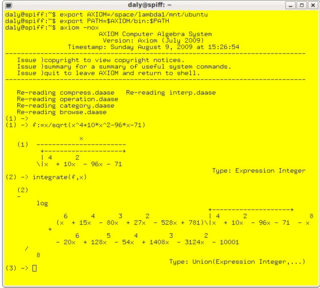
In mathematics and computer science, an algorithm is a finite sequence of rigorous instructions, typically used to solve a class of specific problems or to perform a computation. Algorithms are used as specifications for performing calculations and data processing. More advanced algorithms can use conditionals to divert the code execution through various routes and deduce valid inferences, achieving automation eventually. Using human characteristics as descriptors of machines in metaphorical ways was already practiced by Alan Turing with terms such as "memory", "search" and "stimulus".

In mathematics, the Chinese remainder theorem states that if one knows the remainders of the Euclidean division of an integer n by several integers, then one can determine uniquely the remainder of the division of n by the product of these integers, under the condition that the divisors are pairwise coprime.
In mathematics and computer programming, exponentiating by squaring is a general method for fast computation of large positive integer powers of a number, or more generally of an element of a semigroup, like a polynomial or a square matrix. Some variants are commonly referred to as square-and-multiply algorithms or binary exponentiation. These can be of quite general use, for example in modular arithmetic or powering of matrices. For semigroups for which additive notation is commonly used, like elliptic curves used in cryptography, this method is also referred to as double-and-add.

In mathematics, the Euclidean algorithm, or Euclid's algorithm, is an efficient method for computing the greatest common divisor (GCD) of two integers (numbers), the largest number that divides them both without a remainder. It is named after the ancient Greek mathematician Euclid, who first described it in his Elements . It is an example of an algorithm, a step-by-step procedure for performing a calculation according to well-defined rules, and is one of the oldest algorithms in common use. It can be used to reduce fractions to their simplest form, and is a part of many other number-theoretic and cryptographic calculations.

A hash function is any function that can be used to map data of arbitrary size to fixed-size values, though there are some hash functions that support variable length output. The values returned by a hash function are called hash values, hash codes, digests, or simply hashes. The values are usually used to index a fixed-size table called a hash table. Use of a hash function to index a hash table is called hashing or scatter storage addressing.

In computer science and information theory, a Huffman code is a particular type of optimal prefix code that is commonly used for lossless data compression. The process of finding or using such a code is Huffman coding, an algorithm developed by David A. Huffman while he was a Sc.D. student at MIT, and published in the 1952 paper "A Method for the Construction of Minimum-Redundancy Codes".
In computability theory, Rice's theorem states that all non-trivial semantic properties of programs are undecidable. A semantic property is one about the program's behavior, unlike a syntactic property. A property is non-trivial if it is neither true for every program, nor false for every program.

Linear programming (LP), also called linear optimization, is a method to achieve the best outcome in a mathematical model whose requirements are represented by linear relationships. Linear programming is a special case of mathematical programming.
In computing, partial evaluation is a technique for several different types of program optimization by specialization. The most straightforward application is to produce new programs that run faster than the originals while being guaranteed to behave in the same way.
In mathematics and computing, a root-finding algorithm is an algorithm for finding zeros, also called "roots", of continuous functions. A zero of a function f, from the real numbers to real numbers or from the complex numbers to the complex numbers, is a number x such that f(x) = 0. As, generally, the zeros of a function cannot be computed exactly nor expressed in closed form, root-finding algorithms provide approximations to zeros, expressed either as floating-point numbers or as small isolating intervals, or disks for complex roots (an interval or disk output being equivalent to an approximate output together with an error bound).
Pollard's p − 1 algorithm is a number theoretic integer factorization algorithm, invented by John Pollard in 1974. It is a special-purpose algorithm, meaning that it is only suitable for integers with specific types of factors; it is the simplest example of an algebraic-group factorisation algorithm.

In arithmetic, Euclidean division – or division with remainder – is the process of dividing one integer by another, in a way that produces an integer quotient and a natural number remainder strictly smaller than the absolute value of the divisor. A fundamental property is that the quotient and the remainder exist and are unique, under some conditions. Because of this uniqueness, Euclidean division is often considered without referring to any method of computation, and without explicitly computing the quotient and the remainder. The methods of computation are called integer division algorithms, the best known of which being long division.
In mathematics, the Borel–Weil–Bott theorem is a basic result in the representation theory of Lie groups, showing how a family of representations can be obtained from holomorphic sections of certain complex vector bundles, and, more generally, from higher sheaf cohomology groups associated to such bundles. It is built on the earlier Borel–Weil theorem of Armand Borel and André Weil, dealing just with the space of sections, the extension to higher cohomology groups being provided by Raoul Bott. One can equivalently, through Serre's GAGA, view this as a result in complex algebraic geometry in the Zariski topology.

In computational complexity and optimization the no free lunch theorem is a result that states that for certain types of mathematical problems, the computational cost of finding a solution, averaged over all problems in the class, is the same for any solution method. The name alludes to the saying "no such thing as a free lunch", that is, no method offers a "short cut". This is under the assumption that the search space is a probability density function. It does not apply to the case where the search space has underlying structure that can be exploited more efficiently than random search or even has closed-form solutions that can be determined without search at all. For such probabilistic assumptions, the outputs of all procedures solving a particular type of problem are statistically identical. A colourful way of describing such a circumstance, introduced by David Wolpert and William G. Macready in connection with the problems of search and optimization, is to say that there is no free lunch. Wolpert had previously derived no free lunch theorems for machine learning. Before Wolpert's article was published, Cullen Schaffer independently proved a restricted version of one of Wolpert's theorems and used it to critique the current state of machine learning research on the problem of induction.
In computer science, a term index is a data structure to facilitate fast lookup of terms and clauses in a logic program, deductive database, or automated theorem prover.
A division algorithm is an algorithm which, given two integers N and D, computes their quotient and/or remainder, the result of Euclidean division. Some are applied by hand, while others are employed by digital circuit designs and software.

Fast inverse square root, sometimes referred to as Fast InvSqrt or by the hexadecimal constant 0x5F3759DF, is an algorithm that estimates , the reciprocal of the square root of a 32-bit floating-point number in IEEE 754 floating-point format. The algorithm is best known for its implementation in 1999 in Quake III Arena, a first-person shooter video game heavily based on 3D graphics. With subsequent hardware advancements, especially the x86 SSE instruction rsqrtss, this algorithm is not generally the best choice for modern computers, though it remains an interesting historical example.
An important aspect in the study of elliptic curves is devising effective ways of counting points on the curve. There have been several approaches to do so, and the algorithms devised have proved to be useful tools in the study of various fields such as number theory, and more recently in cryptography and Digital Signature Authentication. While in number theory they have important consequences in the solving of Diophantine equations, with respect to cryptography, they enable us to make effective use of the difficulty of the discrete logarithm problem (DLP) for the group , of elliptic curves over a finite field , where q = pk and p is a prime. The DLP, as it has come to be known, is a widely used approach to public key cryptography, and the difficulty in solving this problem determines the level of security of the cryptosystem. This article covers algorithms to count points on elliptic curves over fields of large characteristic, in particular p > 3. For curves over fields of small characteristic more efficient algorithms based on p-adic methods exist.

In mathematics and computer science, computer algebra, also called symbolic computation or algebraic computation, is a scientific area that refers to the study and development of algorithms and software for manipulating mathematical expressions and other mathematical objects. Although computer algebra could be considered a subfield of scientific computing, they are generally considered as distinct fields because scientific computing is usually based on numerical computation with approximate floating point numbers, while symbolic computation emphasizes exact computation with expressions containing variables that have no given value and are manipulated as symbols.
DNA code construction refers to the application of coding theory to the design of nucleic acid systems for the field of DNA–based computation.






















